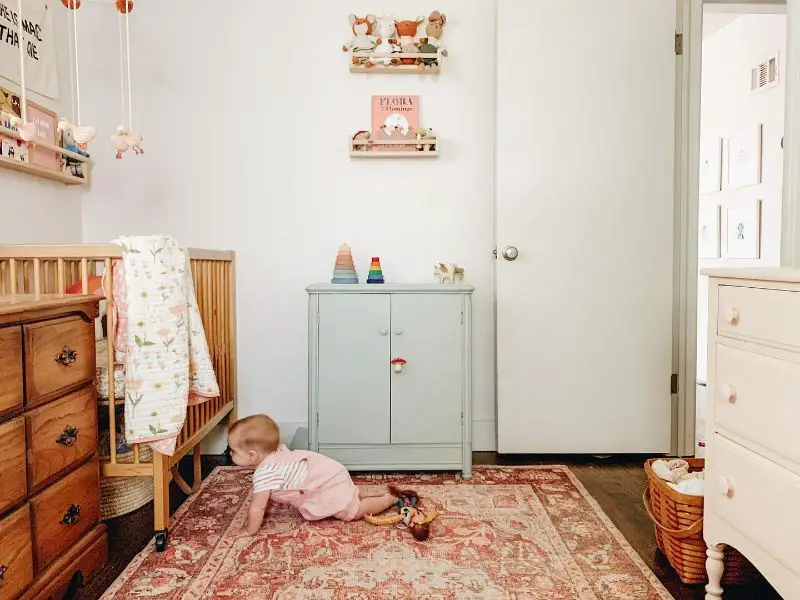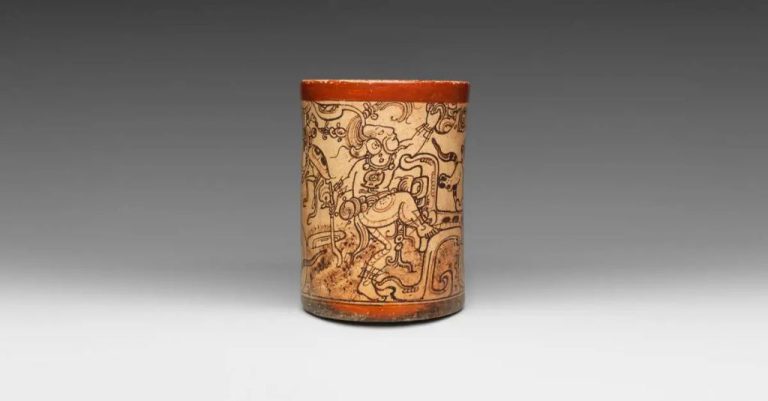How Should A Rug Fit In Nursery?
Having the right rug size is crucial when choosing a rug for your baby’s nursery. The size of the rug will depend on the size of the crib and the layout of the room. You want a rug that is big enough to cover a good portion of the floor, but not so big that it takes up too much space or causes safety issues.
Choosing the proper rug size for a nursery allows you to create a soft, warm play space for your little one. It defines an area for tummy time, playing with toys, and crawling around. The rug brings visual interest to the room and ties the space together aesthetically. Most importantly, the right sized rug prevents accidents and injuries by avoiding tripping hazards.
Standard Crib Size
The standard size for a crib mattress in the United States is approximately 28 inches wide and 52 inches long, though some variation exists between brands. According to the Consumer Product Safety Commission, a standard crib mattress should be at least 27.25 inches wide and 51.25 inches long (https://www.cpsc.gov/s3fs-public/pdfs/blk_media_advisorycrib.pdf). Most cribs are designed to fit these standard crib mattress dimensions. It’s important that the mattress fit snugly in the crib frame without large gaps, usually less than two fingers width between the edge of the mattress and crib side.
While the mattress should fit tightly, it’s recommended to leave some space around the sides of the crib for accessibility and safety. The American Academy of Pediatrics suggests leaving at least two inches between the side of the crib and any structure or furniture next to it like walls or dressers. This provides space to easily reach into the crib to lay your baby down or pick them up. Proper clearance around all four sides also reduces the risk of injury if the baby rolls against the side of the crib.
Crib Safety
When selecting a rug for the nursery, it’s important to consider crib safety. Loose or thick rugs can pose tripping hazards for babies learning to stand and walk. The American Academy of Pediatrics recommends using a tight-weave, low-pile rug no thicker than 1/2 inch under the crib.
Having a properly fitted, cushioned rug can help create a softer landing surface for babies in case they fall or climb out of the crib. Just make sure any rug under the crib is secured in place with rug tape or non-slip pads. Loose rugs can bunch up and should be avoided. When selecting a rug, look for soft, durable materials like wool that provide padding without being overly plush.
Play Area Size
When choosing a rug for a nursery play area, it’s important to select one that leaves enough open floor space for baby to crawl and play comfortably. According to Project Nursery, small rugs like 4×6 or 5×8 can make a room feel cramped, so it’s better to opt for a larger size (Project Nursery). For a 10×12 nursery, an 8×10 rug can allow a nice border around the edges for playing and crawling.

Additionally, Rugs Direct recommends going with a room-size rug for a nursery, one that fills most of the floor. However, be sure to leave at least 2 feet of bare floor around the edges for baby to play on (Rugs Direct). An 8×10 rug achieves this well in a 10×12 room.
The dimensions of the play area rug are key – too small, and baby won’t have enough open space, but too large can make the room feel cramped. An 8×10 rug allows ample play area for most standard 10×12 nursery sizes.
Crawling Space
Having an open space for a baby to crawl and explore is very important for their development. According to Amazon’s guide on baby crawling rugs, a good rule of thumb is to leave at least 6 feet x 8 feet of open floor space for your baby to comfortably crawl and play. This allows them to build coordination and muscles as they learn to move around.
When choosing a rug size and placement in the nursery, be sure to leave plenty of empty floor space around the edges. Oftentimes a 5×7 or 6×9 size rug is recommended to have enough clear floor for crawling and playing. Avoid large rugs that dominate the entire nursery floor. Position the rug off to one side, so your baby has room to move and explore.
As noted in Amazon’s guide on baby crawling rugs, the ideal setup is a rug for playtime surrounded by open space for crawling and learning to walk.
Non-Slip Backing
Having a rug with a non-slip backing is crucial for safety in a nursery. Babies and toddlers spend a lot of time playing on the floor, so you’ll want to ensure the rug stays firmly in place and does not slide around. This helps prevent tripping hazards and injuries.
Look for rugs labeled as having a non-slip, slip-resistant, or gripping backing. Many are made with rubber, latex, or vinyl bottoms to help grip the floor [1]. You can also use a separate rug pad or tape to help anchor the rug.
Rug pads are an affordable way to make an existing rug non-slip. Look for ones made specifically for nurseries and playrooms, as they are thicker and grippier. Be sure to get the right size rug pad for your rug. Having it extend beyond the edges of the rug can also help prevent creeping [2].
Material
When choosing a rug for a nursery, it’s important to select materials that are baby-safe, durable, and easy to clean. Some of the best materials for nursery rugs include wool, cotton, and olefin according to Architectural Digest.
Wool rugs are a great choice because they are soft, comfortable, and naturally stain resistant. The fibers in wool rugs are also hypoallergenic and flame retardant. Make sure to choose wool rugs with a tight weave so little fingers can’t pull threads out easily.
Cotton is another good option as it is breathable, absorbent, and free of toxic chemicals. Cotton rugs come in a range of pile heights and can add a cozy feel to the nursery. They may require more frequent cleaning than wool though.
Olefin, also known as polypropylene, makes durable and stain-resistant nursery rugs. Olefin is a synthetic material that is fade resistant and easy to keep clean. It can also be produced in nearly any color and style. Just be aware that olefin rugs lack the plush feel of natural fibers.
No matter the material, it’s wise to choose low-pile rugs without fringes or tassels. This will prevent babies from grabbing and chewing on the rug. Stick to simple patterns and solid colors as well so the rug is easy to spot clean.
Style
When choosing a rug for your baby’s nursery, many parents opt for gender neutral patterns and soft textures and colors that will work for a boy or girl. Solid rugs, geometric patterns, and subtle floral prints are great gender neutral options that avoid overly masculine or feminine styles. Soft pastels like mint green, blush pink, and pale yellow create a soothing ambience. Off-white, ivory, light gray, and other neutral tones also complement most color schemes. Natural fiber rugs like cotton, wool, jute, and seagrass have inherently soft textures. Go with a low pile height under 1 inch to prevent tripping or fibers getting caught in tiny fingers and toes. A plush shaggy rug can go in a sitting area for tummy time or reading.
Budget
When shopping for a nursery rug, it’s important to find affordable options that don’t compromise on safety or durability. According to Nursery Rugs – Amazon, there are quality rugs available for under $100. Focus on finding a tightly woven, low pile rug without fringes or loops that could be hazardous for babies. Natural fibers like cotton and wool tend to be more durable and easier to clean than synthetic rugs. Prioritize safety certifications like Oeko-Tex Standard 100 to ensure any dyes or chemicals used are baby-safe. It’s also wise to choose muted, light colors that won’t show stains over time. With some savvy shopping, you can find an attractive, soft, and sturdy rug to anchor your nursery’s design while staying within budget.
Conclusion
When selecting a rug for your nursery, there are several key factors to consider. The size and dimensions should complement the standard crib size while allowing adequate crawling space. Ensure the rug has a non-slip backing for safety and is made of soft, durable materials that can withstand wear and tear. The style and colors should fit your nursery theme and budget. Most importantly, choose a properly-fitted rug that provides a soft, cushy surface for your baby to play and grow on.
Having the right rug enhances both the safety and comfort of your nursery. Babies spend a lot of time playing on the floor, so ensure the rug adequately cushions falls and bumps. A rug also defines the play space, protecting your baby from crawling too far. Take the time to measure your nursery and find the perfect rug to complete your baby’s room.


